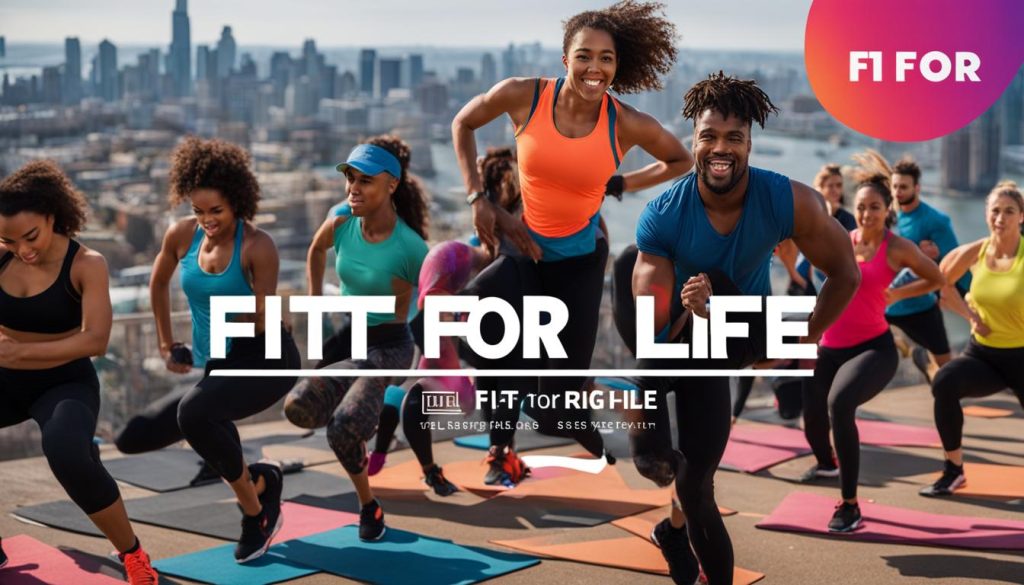
As the health and fitness industry continues to thrive, effective marketing strategies have become crucial for businesses in this competitive market. With the growing popularity of health and fitness, it is essential for brands to stand out and engage with their target audience. In this article, I will explore various health and fitness marketing strategies that can help businesses grow and succeed in the wellness industry.
Key Takeaways:
- Health and fitness marketing is essential for growing businesses in the wellness industry.
- Digital marketing plays a vital role in reaching and engaging with target audiences.
- Marketing for gyms and fitness centers is crucial for attracting and retaining customers.
- Influencer marketing and video marketing are effective strategies for promoting health and wellness.
- User-generated content and social media advertising help build credibility and brand visibility.
Importance of Marketing for Fitness Businesses
Effective marketing plays a vital role in the success of fitness businesses, regardless of their size. A well-planned marketing strategy helps attract and retain customers, build brand awareness, and seize new opportunities in the competitive fitness industry.
In today’s digital age, relying solely on word-of-mouth promotion is no longer sufficient. Fitness businesses need to embrace digital marketing methods to reach a wider audience and stay ahead of their competitors.
Here are some key reasons why marketing for gyms and fitness centers is essential:
- Attract and Retain Customers: A robust marketing strategy allows fitness businesses to showcase their unique offerings, special promotions, and value propositions. By effectively communicating the benefits of their services, businesses can attract new customers and retain existing ones.
- Build Brand Awareness: Marketing helps create brand recognition and visibility in the crowded fitness industry. By consistently promoting their brand message across different channels, fitness businesses can establish a strong presence in the market and attract a loyal customer base.
- Seize New Opportunities: Marketing provides businesses with the opportunity to identify and tap into emerging trends and market demands. By continuously analyzing market insights and customer preferences, fitness businesses can adapt their offerings, introduce new products or services, and diversify revenue streams.
Now, let’s explore some essential fitness marketing tips:
- Create Compelling Content: Develop engaging content that resonates with your target audience. This can include blog posts, social media videos, and informative guides that provide value and establish your expertise in the industry.
- Optimize Your Online Presence: Ensure your website is user-friendly, mobile-responsive, and search engine optimized. Utilize local SEO strategies to appear in relevant local searches and directories.
- Utilize Social Media: Leverage social media platforms to connect with your audience, share inspiring stories, and showcase your fitness facilities. Engage with followers, respond to comments, and utilize paid social media advertising to expand your reach.
- Offer Special Promotions: Create exclusive offers, discount codes, or referral programs to incentivize new sign-ups and encourage customer loyalty.
- Partner with Influencers: Collaborate with fitness influencers who align with your brand values and have a dedicated following. Their endorsement and recommendations can significantly impact your brand awareness and attract new customers.
By implementing these fitness marketing tips, you can effectively promote your fitness business and stand out in the competitive fitness industry.
| Marketing Tips for Fitness Businesses | Benefits |
|---|---|
| Create Compelling Content | Establish expertise and engage with audience |
| Optimize Your Online Presence | Enhance visibility and attract local customers |
| Utilize Social Media | Connect with audience and expand reach |
| Offer Special Promotions | Incentivize new sign-ups and encourage loyalty |
| Partner with Influencers | Build brand awareness and attract new customers |
Digital Marketing Strategies for Health and Wellness
In today’s fast-paced digital world, effective marketing strategies are crucial for businesses in the health and wellness industry. By leveraging the power of digital marketing, businesses can reach their target audience more effectively and promote their offerings. In this section, I will explore various digital marketing strategies that can help health and wellness businesses thrive.
- Influencer Marketing: Influencer marketing has gained significant traction in recent years. Collaborating with influential individuals in the health and wellness space can help businesses expand their reach and engage with a dedicated audience. Utilizing influencers who align with the brand’s values and target audience can create impactful campaigns and drive brand awareness.
- Video Marketing: Video content has become increasingly popular in digital marketing. Businesses can leverage video marketing to showcase their products and services, provide informative content, and build trust with viewers. Videos can be used to demonstrate workout routines, offer healthy cooking tips, or share success stories, creating a personal connection with the audience.
- Social Media Promotion: Social media platforms provide a fertile ground for promoting health and wellness services. By creating engaging content, such as educational posts, inspiring stories, and fitness challenges, businesses can attract and connect with their target audience. Utilizing targeted advertising on platforms like Facebook and Instagram can further enhance the visibility and reach of health and wellness campaigns.
- User-Generated Content: User-generated content (UGC) plays a crucial role in building credibility and trust for health and wellness businesses. Encouraging customers to share their fitness journey, testimonials, or success stories can create a sense of community and authenticity around the brand. Sharing UGC on social media and websites can attract new customers and inspire others to embark on their own health and wellness journeys.
- Email Marketing: Email marketing is a powerful tool for nurturing relationships with customers and driving repeat business. By sending personalized email campaigns, businesses can provide valuable content, exclusive offers, and updates to their target audience. Incorporating SEO optimization techniques in email content can also increase the visibility of health and wellness businesses in online searches.
By implementing these digital marketing strategies, businesses in the health and wellness industry can effectively promote their products and services, engage with their target audience, and drive growth in the competitive market.

| Digital Marketing Strategies | Benefits |
|---|---|
| Influencer Marketing | Expanded reach and engagement with a dedicated audience |
| Video Marketing | Showcasing offerings and building trust with viewers |
| Social Media Promotion | Increased brand visibility and engagement |
| User-Generated Content | Building credibility and attracting new customers |
| Email Marketing | Nurturing customer relationships and driving repeat business |
The Growing Health and Fitness Industry
The health and fitness industry in the United States has experienced significant growth over the past decade, becoming a thriving market worth over $30 billion. This trend shows no signs of slowing down, with consumers prioritizing their health and well-being more than ever before. One notable shift in consumer preferences is the growing popularity of fitness boutiques, which offer specialized and personalized fitness experiences.
Americans are investing heavily in their health and fitness, spending an average of $155 per month on gym memberships, fitness classes, and wellness services. This increased spending indicates a strong demand for quality health and fitness offerings. Furthermore, the global wellness market has surpassed the pharmaceutical industry, estimated to be worth a staggering $3.4 trillion.
These statistics highlight the immense potential within the health and fitness industry. Businesses in this sector have ample opportunities to capitalize on this growth by implementing effective marketing strategies. By understanding the current trends and consumer behaviors, businesses can successfully promote their offerings and thrive in this competitive market.
With the right fitness industry marketing strategies, businesses can attract and retain customers, build brand awareness, and drive growth. In this section, we will explore the latest marketing trends in the fitness industry, as well as effective health and fitness promotions that businesses can leverage to achieve their marketing goals.

The Growing Health and Fitness Industry: Key Statistics
| Industry Worth | Average Monthly Expenditure |
|---|---|
| $30+ billion | $155 |
“The health and fitness industry presents immense opportunities for businesses to thrive, given the exponential growth and significant consumer spending in this sector.”
With the fitness industry continuing its upward trajectory, businesses need to stay ahead of the marketing curve to remain competitive. By keeping in tune with the latest marketing trends and adopting innovative health and fitness promotions, businesses can tap into the growing market and establish their brand as a leader in the industry.
Targeting Millennial and Gen-Z Audiences
When it comes to health and fitness marketing, it is crucial to target millennial and Gen-Z audiences. These demographic groups make up a significant portion of gym memberships and are the key decision-makers when it comes to fitness-related purchases.
Social media platforms, particularly Instagram, are effective channels for reaching and engaging with these audiences. With millennial and Gen-Z individuals spending a considerable amount of time on social media, leveraging these platforms can create valuable opportunities for health and wellness businesses.
To effectively target and connect with millennial and Gen-Z audiences, it is essential to utilize specific strategies:
- Create Engaging Video Content: Millennial and Gen-Z audiences are highly influenced by video content. By producing compelling and informative videos that showcase your fitness offerings, you can grab their attention and drive engagement.
- Collaborate with Influencers: Influencer marketing has become a powerful tool in the digital age. Partnering with fitness influencers who resonate with millennial and Gen-Z audiences can significantly boost brand visibility and credibility.
- Utilize Social Media Advertising: Running targeted ad campaigns on social media platforms allows you to reach specific age groups, interests, and locations. By optimizing your ads based on the preferences of millennial and Gen-Z audiences, you can maximize their effectiveness.

“Digital marketing enables health and wellness brands to precisely target millennial and Gen-Z audiences, ensuring their promotional efforts resonate with these key demographic groups.” – Mark Johnson, Digital Marketing Expert
Comparison of Health and Fitness Preferences between Millennial and Gen-Z Audiences
| Millennials | Gen-Z | |
|---|---|---|
| Preferred Workout Types | Yoga, Crossfit | HIIT, Dance Fitness |
| Preferred Fitness Apps | MyFitnessPal, Nike Training Club | Fitness Blender, Sweat |
| Preferred Fitness Wearables | Fitbit, Apple Watch | Garmin, Samsung Galaxy Watch |
By understanding the unique preferences and behaviors of millennial and Gen-Z audiences, health and wellness businesses can tailor their marketing strategies to resonate with these key demographic groups. When effectively targeting and engaging with millennial and Gen-Z audiences, businesses have the potential to increase brand visibility, drive customer acquisition, and build long-lasting relationships.
Effective Advertising on Social Media
When it comes to fitness advertising and health and fitness promotions, social media platforms have become indispensable tools for businesses. Engaging with audiences on platforms like Facebook and Instagram can significantly boost brand awareness and promote health and wellness practices. To harness the power of social media, it is crucial to keep your social media handles up-to-date with relevant and trending posts that resonate with your target audience.
Social media advertising tools, such as Facebook ads and organic posts, offer businesses the opportunity to reach their target audience effectively and drive conversions. With precise targeting options, you can tailor your fitness advertising campaigns to reach specific demographics, interests, and behaviors, ensuring your message is delivered to the right people at the right time.
User-generated content also plays a vital role in building trust and promoting your brand. Encourage your customers to share their fitness journey, success stories, and testimonials. This user-generated content not only serves as social proof but also helps create a sense of community and drives engagement with your brand.
Best Practices for Effective Social Media Advertising:
- Define Your Target Audience: Identify your ideal customers and create buyer personas to understand their demographics, interests, and pain points.
- Create Compelling Visual Content: Use high-quality images and videos to capture attention and showcase the benefits of your health and fitness products or services.
- Craft Engaging Ad Copy: Write persuasive and compelling ad copy that highlights the unique selling points of your offerings and encourages users to take action.
- Utilize Influencer Partnerships: Collaborate with fitness influencers who align with your brand values and have a dedicated following. Their endorsement can greatly impact brand visibility and drive conversions.
- Experiment with Different Ad Formats: Test various ad formats, such as carousel ads, video ads, and collection ads, to find the ones that resonate best with your target audience.
- Track and Analyze Performance: Monitor the performance of your social media ads, track key metrics, and make data-driven optimizations to maximize your return on investment.
By leveraging the power of social media advertising and incorporating these best practices, businesses in the health and fitness industry can effectively reach their target audience, boost brand awareness, and drive meaningful engagement and conversions.
The Power of User-Generated Content
In the health and fitness industry, user-generated content (UGC) has emerged as a powerful marketing tool. UGC refers to content created by customers, brand loyalists, and employees, which helps build credibility and trust. It can take various forms, such as photos, videos, reviews, and testimonials.
Sharing UGC on social media platforms is an effective way to amplify its impact. By leveraging the influence of customers, businesses can significantly improve brand visibility and attract new customers. UGC allows real people to showcase their experiences, which resonates with potential customers who may relate to their stories.
“Seeing genuine, authentic content from real customers can make a big difference in the perception of a brand. It creates a sense of trust and credibility that traditional advertising often cannot match.”
– Fitness Enthusiast
Benefits of User-Generated Content in Health and Fitness Marketing
1. Establishes Trust and Credibility: UGC provides social proof that demonstrates that real people have had positive experiences with a brand or its products/services, building trust and credibility.
2. Expands Reach and Brand Visibility: By sharing UGC on social media platforms, businesses can extend their reach beyond their existing customer base, reaching a wider audience and increasing brand visibility.
3. Engages and Inspires Customers: UGC has the power to engage and inspire potential customers. Seeing others achieve their fitness goals can motivate individuals to take action and become customers themselves.
4. Enhances Brand Authenticity: UGC adds an authentic touch to a brand’s marketing efforts. It showcases real people and their experiences, demonstrating that the brand is genuine and transparent.
Tips for Leveraging User-Generated Content Effectively
1. Encourage and Incentivize Customers to Create UGC: Offer incentives, such as discounts, giveaways, or recognition, to encourage customers to share their experiences with your brand.
2. Create a Hashtag for UGC: Develop a unique hashtag that customers can use when sharing their content. This makes it easier for you to discover and track UGC related to your brand.
3. Engage with UGC: Interact with customers who create UGC by liking, commenting, and sharing their content. This shows appreciation for their contributions and encourages further engagement.
4. Obtain Permission to Use UGC: Before sharing UGC, always seek permission from the creator. This helps protect both the brand and the individual while ensuring ethical and legal compliance.
5. Actively Monitor and Curate UGC: Regularly monitor social media platforms and websites where UGC may appear. Curate and highlight the most compelling and relevant content to showcase the best of customer experiences.
“User-generated content is a goldmine of valuable marketing assets. By leveraging the power of real people sharing their experiences, businesses can create meaningful connections with potential customers and drive growth in the health and fitness industry.”
– Marketing Expert
By harnessing the power of user-generated content, businesses in the health and fitness industry can create a genuine connection with their audience, build trust, and ultimately drive growth and success.
Email Marketing for Health and Fitness
Email marketing continues to be a vital tool in the promotion of health and fitness products and services. With billions of email users worldwide, businesses have the opportunity to reach potential customers and nurture relationships with existing ones through targeted email campaigns. By leveraging the power of email marketing, health and fitness businesses can effectively engage with their audience and drive growth in the industry.
One of the key advantages of email marketing is its cost-effectiveness. Compared to other forms of marketing, such as advertising or direct mail, email campaigns can be executed at a fraction of the cost. This makes it an attractive option for businesses of all sizes, including gyms, fitness centers, and wellness brands looking to maximize their marketing budget.
When implementing email marketing for health and fitness, personalization is key. By segmenting subscribers based on demographics and interests, businesses can tailor their email content to specific target groups. For example, a gym may want to send workout tips and class schedules to members, while a wellness brand may focus on promoting new products to subscribers interested in natural remedies.
The use of captivating subject lines is crucial in ensuring that emails are opened and read. Engaging subject lines that speak directly to the interests or pain points of the audience can significantly increase the open rate. Once the email is opened, the content should be concise, informative, and visually appealing. Including compelling images and clear call-to-action buttons can encourage recipients to take the desired action.
Email marketing allows health and fitness businesses to develop a direct line of communication with their audience, fostering trust and building brand loyalty. By providing valuable content, such as fitness tips, healthy recipes, and exclusive offers, businesses can establish themselves as authorities in their respective niches and keep customers engaged.
Additionally, utilizing automated workflows and personalized email sequences can further enhance the effectiveness of email marketing campaigns. For example, fitness centers can set up automated emails to welcome new members, provide onboarding information, and offer exclusive promotions. This level of personalization helps create a seamless customer journey and increases customer satisfaction.
When it comes to measuring the success of email campaigns, key metrics to track include open rates, click-through rates, conversion rates, and overall engagement. By analyzing these metrics, health and fitness businesses can gain insights into the effectiveness of their email marketing efforts and make informed decisions to optimize future campaigns.
In summary, email marketing is a powerful tool for health and fitness businesses looking to promote their products and services. With its cost-effectiveness, personalization capabilities, and direct communication with the audience, email marketing can drive customer engagement and loyalty. By implementing effective email marketing strategies, businesses can leverage the full potential of this marketing channel and stay ahead in the competitive health and fitness industry.
How Can Marketing Strategies Promote Fitness and Health Management for a Healthier World?
Effective fitness and health management strategies can play a crucial role in promoting a healthier world. Marketing these strategies can create greater awareness and encourage people to prioritize their health. By highlighting the benefits and positive outcomes, marketing can inspire individuals to embrace a healthier lifestyle.
Conclusion
Health and fitness marketing is vital for promoting healthier lifestyles and elevating brands in the wellness industry. With the growing health and fitness industry, businesses have numerous opportunities to thrive, but effective marketing strategies are crucial for success. Digital marketing, including influencer marketing, video marketing, social media advertising, user-generated content, and email marketing, plays a pivotal role in reaching and engaging target audiences. By implementing these strategies and staying up-to-date with industry trends, businesses can effectively promote their offerings and drive growth in the health and fitness market.
In today’s digital age, businesses in the health and fitness industry need to leverage the power of digital marketing. Influencer marketing allows brands to collaborate with fitness influencers, who have a dedicated following and can positively impact the target audience. Video marketing allows businesses to visually showcase their products and services, building trust and credibility. Social media advertising enables effective targeting and reaching a wide range of potential customers. By encouraging user-generated content, businesses can tap into the power of their customers as brand advocates. Furthermore, email marketing remains a cost-effective tool to nurture relationships with existing customers and reach potential ones.
To succeed in the competitive world of health and fitness marketing, businesses need to stay on top of industry trends and adapt their strategies accordingly. By combining effective digital marketing techniques with a deep understanding of target audiences, businesses can position themselves as industry leaders and drive growth. In conclusion, health and fitness marketing, coupled with digital marketing strategies, provides businesses with the tools they need to thrive in the ever-expanding health and wellness market.
FAQ
What is health and fitness marketing?
Health and fitness marketing refers to the strategies and techniques used to promote health and wellness products and services. It involves targeting and engaging with the target audience, building brand awareness, and driving customer acquisition and retention.
Why is marketing important for fitness businesses?
Marketing is crucial for fitness businesses as it helps attract and retain customers, build brand awareness, and seize new opportunities. In today’s competitive market, effective marketing strategies are essential for business growth and success.
What are some digital marketing strategies for health and wellness?
Digital marketing strategies for health and wellness include influencer marketing, video marketing, social media advertising, user-generated content, and email marketing. These strategies help businesses reach and engage with their target audience effectively.
What are the trends and opportunities in the health and fitness industry?
The health and fitness industry is experiencing steady growth, with a shift towards specialized fitness experiences and increased consumer spending. Businesses can leverage these trends and opportunities to enhance their marketing efforts and drive growth.
How can businesses target millennial and Gen-Z audiences in the health and fitness industry?
To target millennial and Gen-Z audiences, businesses can utilize social media platforms such as Instagram and incorporate video content and influencer partnerships. These strategies help businesses connect with the younger demographic and effectively promote their offerings.
How can businesses effectively advertise on social media in the health and fitness industry?
Businesses can effectively advertise on social media platforms by keeping their handles up-to-date with relevant and trending posts, leveraging social media advertising tools, and utilizing user-generated content to build trust and promote their brand.
What is the power of user-generated content in health and fitness marketing?
User-generated content, created by customers, brand loyalists, and employees, helps build credibility and trust. By sharing user-generated content on social media platforms and leveraging the influence of customers, businesses can significantly impact brand visibility and attract new customers.
Why is email marketing important in the health and fitness industry?
Email marketing remains a powerful and cost-effective tool for promoting health and fitness products and services. By utilizing targeted email campaigns and personalization, businesses can reach potential customers, nurture relationships with existing ones, and maximize the impact of their marketing efforts.






